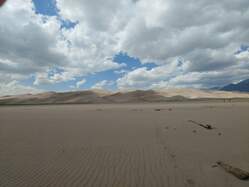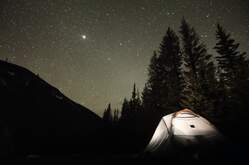UFO Watchtower Presents
San Luis Valley MUST See Stops
Other Interesting Stops To Make While In The Mystical San Luis Valley

Open 24/7 year round! There are no limitations or reservations to visit, but there is currently limited capacity in the visitor center.
The tallest dunes in North America are the centerpiece in a diverse landscape of grasslands, wetlands, forests, alpine lakes, and tundra. Stay on a moonless night to experience this International Dark Sky Park's starry skies!


Located just 17 miles north of Alamosa on Hwy. 17. Here geothermal wells keep the water at 87°, aiding in the production of alligators and fish. The Two Mile Creek Wildlife Habitat provides the opportunity to view gators in a natural setting, to fish and go boating, nature trail hiking and picnicking. Tours are available. Open daily from 9:00 a.m. to 5:00 p.m., October through April, and 9:00 a.m. to 7:00 p.m., May through September. Click on website for Gatorfest details. It will be the world's first Gator Rodeo and Roundup, with roping, riding, and barrel racing.


Saguache is the northern gateway to the San Luis Valley in South Central Colorado. It sits at an elevation of 7800 feet, surrounded by the Sangre de Cristo mountain range on the east and the San Juan range on the west. Many of the peaks are 14000 feet, a great challenge to climbers.


As you arrive at the Monte Vista National Wildlife Refuge, you'll be greeted by the "gar-oo-oo" of sandhill cranes, the quacks of mallard ducks, and the vibrant whistling songs of western meadowlarks. It's natures way of saying "Hello and Welcome!" You will also find beautiful vistas of wetlands and meadows that make up great portions of the Refuge. As a backdrop to the Refuge's many scenic vistas, visitors can also enjoy amazing sunrises and sunsets provided by the nearby San Juan Mountains.


Located in Rio Grande and San Isabel National Forests Neighboring towns: Salida, Poncha Springs, Wellsville, Howard, Coaldale, Alamosa, Westcliffe.
From the San Luis Valleys, the Sangre de Cristo Mountains extend literally to the ends of the horizon. The wilderness area, one of Colorado's newest, includes the entire range north of Blanca Peak, spanning 70 miles to its terminus at Salida.


The Rio Grande National Forest is home to a large variety of plants and animals. Common large animals in the area include elk, mule deer, pronghorn, and many others. The most seen smaller animals and birds include coyote, fox, beaver, bobcat, magpies, hummingbirds, bald and golden eagles and much more. During almost all of the seasons, the forest provides opportunities for amazing wildlife viewing.
After a long day of adventures in the San Luis Valley, a dip in the JOYFUL JOURNEY Hot Spring is a must! You can relax while you enjoy the breathtaking view of the cosmos in this NO LIGHT POLLUTION valley.


San Luis Lakes State Park is 2,369 acres alive with numerous wildlife, including several species of waterfowl, migratory birds, raptors, amphibians and mammals. The park and wetlands are located near the Great Sand Dunes National Monument, allowing for outstanding wildlife habitat and wildlife viewing. The best viewing times are in the Spring and Summer. Camping is available, as well as waterfowl, small game and dove hunting, when in season.


Alamosa’s close proximity to a multitude of sights and attractions makes it an ideal spot for travelers and weekend warriors alike. All within a few hours, you can summit North America’s tallest sand dunes, wrestle local alligators, go chasing waterfalls, and still make it back to the hot springs by sunset for some unfiltered Rest and Relaxation.


The Blanca Wetlands Area is located in east-central Alamosa County. Currently, visitors are allowed to fish in the summer and winter, hunt waterfowl during hunting season, practice photography and observe wildlife. Alamosa County, with the Bureau of Land Management has taken great care of this area in maintaining its purity and safety for the wildlife.
One of colorado's lesser known wilderness areas, the La Garita Wilderness is, in fact, one of the state's original five. Lagarita means "the lookout" in Spanish, and this wilderness amply deserves the name. From the summit of this wilderness's single fourteener (14,014 foot San Luis Peak), climbers can gaze across the upper Rio Grande Valley and down the long stretch of the San Luis Valley. About 35 miles of the Continental Divide lie well above a sprawling forestland that provides ideal habitats for huge numbers of elk and mule deer.


Snow melt from the San Juan Mountains flows through a thirsty landscape across the San Luis Valley to one of the longest rivers in the country: The Rio Grande. Nearby, Zapata Falls — a secluded 25-foot waterfall sheltered in a rocky crevasse — is welcome respite for visitors to south-central Colorado.


Natural Hot Artesian Oasis
Many call the South San Juan Wilderness Colorado's wildest corner. True, the landscape here, one broken volcanic peaks and cliffs, poses a formidable barrier to travel, but the overriding reason for this reputation resides in the probable presence of one critter - the ("griz"). Of all the places in Colorado likely to still harbor North America's most fearsome creature, the rugged and remote southern San Juan Mountains seem best suited. A great bear was killed here in 1979, the last known Colorado grizzly. But rumor, extrapolation and scientific evidence all join hands to suggest strongly that more grizzlies, if they still live anywhere in Colorado, inhabit the recesses of this rugged Wilderness, which many claim as the wildest left in the state.

UFOWATCHTOWER@yahoo.com
Call 719-378-2296
UFO Watchtower Home
The Garden
Cattle-Mutilations
Related Topic Websites

©2000 ~ 2024 UFO WATCHTOWER®.COM
~ All rights reserved. No part of this publication may be reproduced, stored or transmitted in any form or by any means, without permission in writing from the publisher.
~Website questions, copyright issues, ( I will be happy to remove ) please contact Lucy Sniela at UFOWatchtower@msn.com
This has been a WebbieLand.Net Production